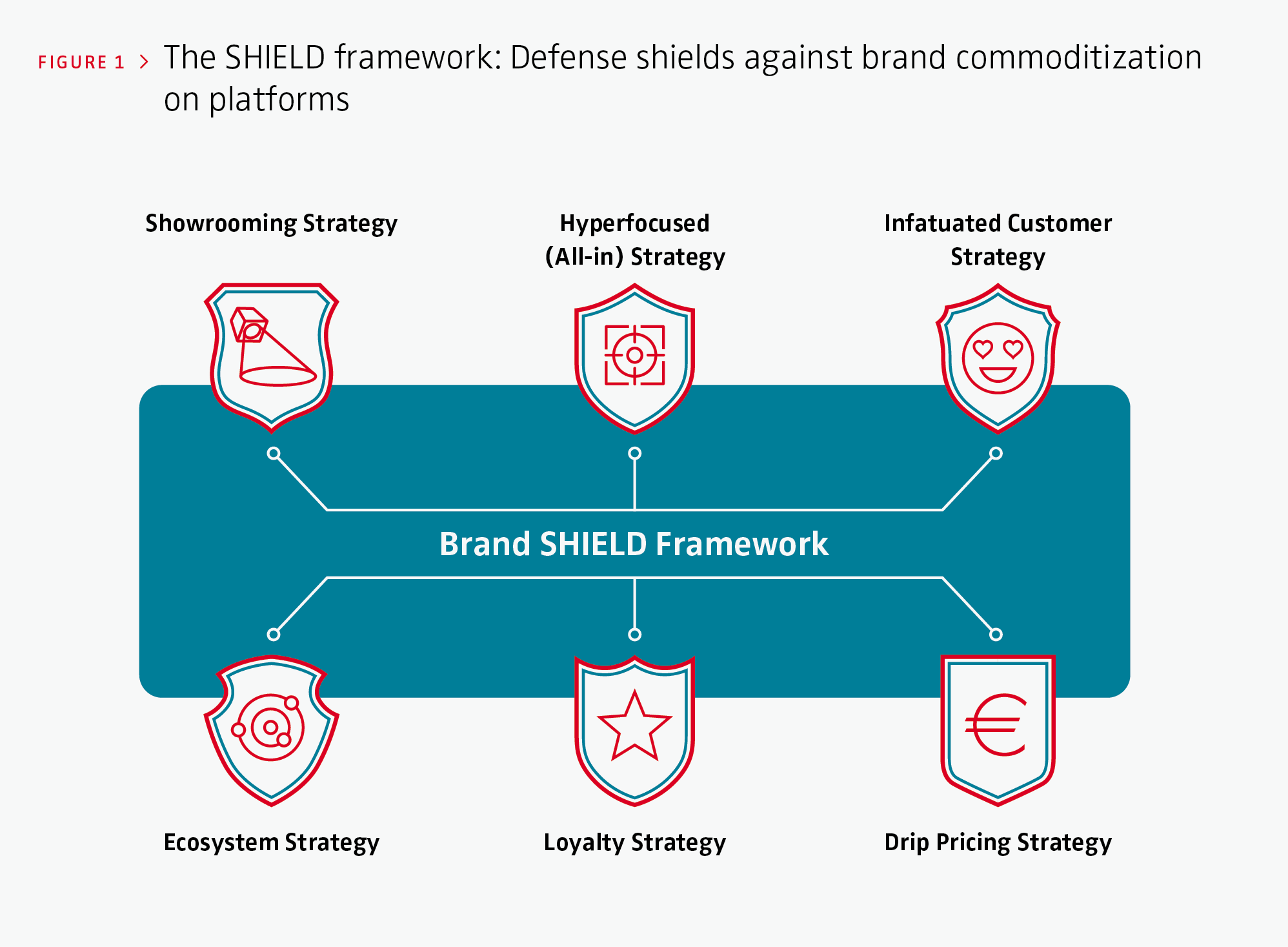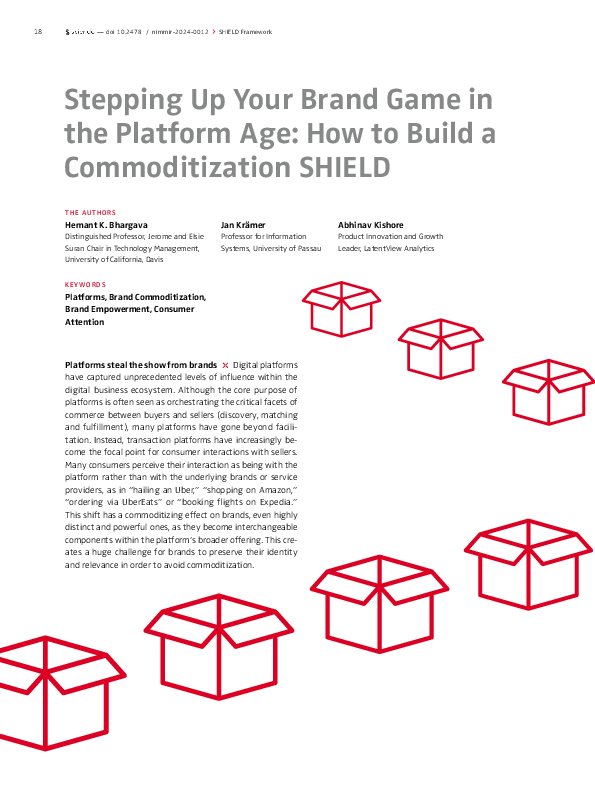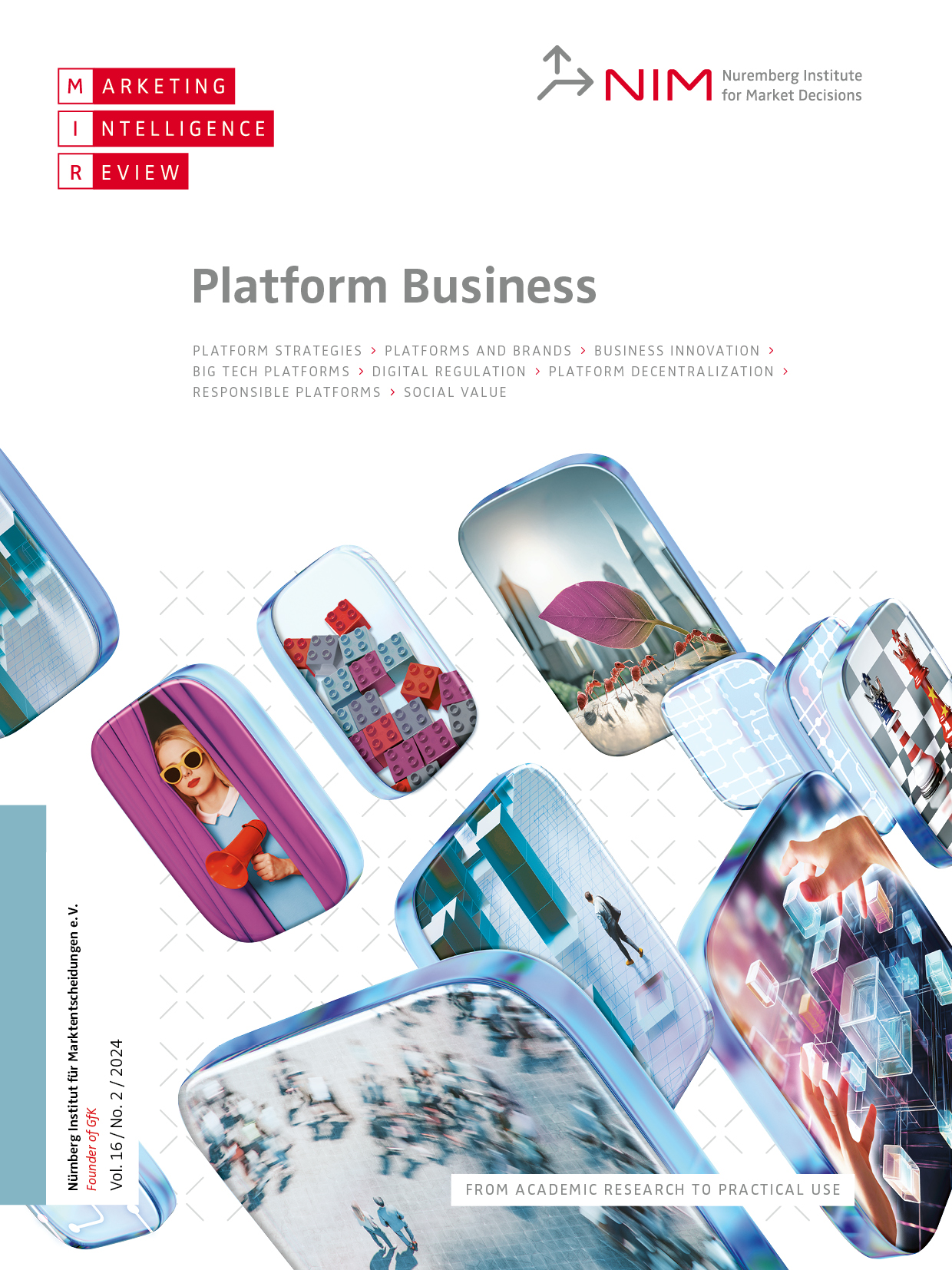Stepping Up Your Brand Game in the Platform Age: How to Build a Commoditization SHIELD
Platforms steal the show from brands
Digital platforms have captured unprecedented levels of influence within the digital business ecosystem. Although the core purpose of platforms is often seen as orchestrating the critical facets of commerce between buyers and sellers (discovery, matching and fulfillment), many platforms have gone beyond facilitation. Instead, transaction platforms have increasingly become the focal point for consumer interactions with sellers. Many consumers perceive their interaction as being with the platform rather than with the underlying brands or service providers, as in “hailing an Uber,” “shopping on Amazon,” “ordering via UberEats” or “booking flights on Expedia.” This shift has a commoditizing effect on brands, even highly distinct and powerful ones, as they become interchangeable components within the platform’s broader offering. This creates a huge challenge for brands to preserve their identity and relevance in order to avoid commoditization. Brands must navigate a market dynamic where platforms control key aspects of the consumer experience and brand interaction, often diminishing the brand’s direct relationship with its customers. In this environment, brands are compelled to find innovative strategies to reclaim their identity and forge stronger connections with their customer base, ensuring they remain competitive and avoid the commoditization trap that platform dominance can exacerbate.
The SHIELD framework is a critical blueprint for brands striving to excel within highly competitive platforms.
The SHIELD framework: Combating commoditization on platforms
We suggest a comprehensive strategy framework, SHIELD, to help brands navigate and thrive in the competitive landscape of platforms. The SHIELD framework is designed to empower brands to stand out and prosper within the competitive dynamics of platforms. SHIELD symbolizes a robust defense mechanism that enables brands to safeguard their unique identity, foster direct customer engagement and shield against commoditization. Figure 1 illustrates its individual components, which we discuss below.

> Showrooming strategy
The showrooming strategy effectively utilizes digital platforms to maximize product visibility, simultaneously driving consumers toward direct channels for exclusive purchases. This approach capitalizes on the extensive reach of online platforms to highlight offerings and then incentivizes customers to engage directly with the brand for purchases, allowing them to fully explore and experience the brand’s offerings. By strategically balancing platform visibility with direct channel exclusivity, brands can enhance their prestige, control the customer experience more effectively and boost direct sales. Chipotle adeptly employs the showrooming strategy by leveraging social media buzz, as seen with the launch of its Fajita Quesadilla, inspired by a viral TikTok trend. By announcing this new product, Chipotle generated significant interest and anticipation. However, the actual purchase of the Fajita Quesadilla is facilitated through Chipotle’s direct channels, such as its website and app, where customers can customize their orders and enjoy exclusive deals. By advertising these app-exclusive deals, Chipotle draws attention to its direct channels, encouraging customers to engage directly with the brand and enjoy benefits unavailable on third-party platforms such as DoorDash and UberEats. Implementing the showrooming strategy, as demonstrated by Chipotle, leads to numerous advantages, including elevated brand prestige, as customers are drawn to the exclusivity of offers available only through direct channels. Furthermore, it allows for a more controlled and tailored customer experience, directly impacting customer satisfaction and loyalty
> Hyperfocused (all-in) strategy
The hyperfocused (all-in) strategy emphasizes a brand’s commitment to exclusivity by choosing to sell through a specific platform and no other channels. This approach, which seems counterintuitive because it increases dependence on the platform, can actually serve the brand well, employing a concentrated effort to dominate a niche within the chosen platform and ensuring that all marketing, sales and customer engagement efforts are streamlined and focused. By partnering exclusively with one platform, brands can leverage the platform’s unique strengths and audience, creating a powerful synergy that enhances brand visibility and market penetration. This strategy not only simplifies the purchasing process for customers but also allows brands to closely control the presentation and pricing of their products, maximizing their impact within the platform’s ecosystem. Anker, specializing in mobile charging solutions, adopted the hyperfocused strategy approach by partnering exclusively with Amazon in the US. This exclusivity allowed Anker to concentrate its efforts on leveraging Amazon’s extensive reach and sophisticated logistical capabilities to serve its customer base effectively. The decision to focus solely on Amazon has enabled Anker to tailor its marketing strategies, optimize its product listings and engage directly with customers through the platform’s review system, driving brand recognition and loyalty within the platform’s vast marketplace. That led to rapid growth, and once Anker became established, it expanded to other platforms. Anker now leverages the other SHIELD strategies and also has its own website where users can buy directly. The adoption of the hyperfocused strategy offers several significant advantages, including enhanced brand visibility. Exclusive partnerships often bring increased promotional support from the chosen platform, thereby amplifying the brand’s presence among a targeted user base.
> Infatuated customer strategy
Central to the infatuated customer strategy is the increase of personalized experiences that cater directly to the unique needs and preferences of each customer. This approach employs targeted marketing, customer engagements and robust direct-to-consumer channels to foster a deep connection with customers, ensuring they feel valued and understood. By prioritizing personalization and direct engagement, brands can cultivate a strong sense of community and belonging among their customer base, driving repeat business. LEGO’s infatuated customer strategy is exemplified through its LEGO Ideas platform, where enthusiasts submit and vote on user-generated LEGO set designs, fostering a vibrant community and deepening brand engagement. This innovative approach not only cultivates creativity but also offers participants the unique opportunity to see their designs become official LEGO products, enhancing their connection and loyalty to the brand. LEGO Ideas demonstrates the power of involving customers directly in product development, significantly increasing engagement and fostering a collaborative brand-community relationship that makes LEGO stand out from competitors on platforms such as Amazon.
Many platforms have gone beyond facilitation and have increasingly become the focal point for consumer interactions with sellers.
> Ecosystem strategy
The ecosystem strategy is about creating a comprehensive network of complementary products, services and experiences that collectively enhance the brand’s value proposition to customers. This approach fosters a deep, enduring connection between the brand and its customers by integrating various aspects of the customer’s lifestyle with the brand’s offerings. The goal is to weave the brand into the fabric of the customer’s daily life, making it indispensable to platforms and fostering a loyal community around it. Nike not only integrates its sportswear with fitness apps and sensors but also extends its ecosystem through services like Nike Run Club and Nike Training Club, community events and personalized coaching programs. This holistic approach encourages not just the purchase of products but a commitment to a lifestyle that Nike represents. The ecosystem is designed to support customers in their fitness journeys by offering motivation, advice and a sense of belonging to a wider community. This strategy leverages digital channels to keep the conversation going, from social media engagement to app-based tracking and sharing, reinforcing the brand’s presence in the customer’s life. The value for customers increases with each additional product or service they use, making it more likely they will continue to choose Nike over competitors, which illustrates the power of an ecosystem to prevent a brand from getting commoditized on platforms such as Amazon. The ecosystem strategy embeds the brand into the lifestyle of its consumers and makes each product a unique part of an ecosystem. It leads to higher customer lifetime value as individuals are more likely to make repeated purchases within the ecosystem.
> Loyalty strategy
The loyalty strategy emphasizes creating and nurturing long-term customer relationships through loyalty programs, rewards and consistent value delivery. This strategy recognizes and rewards customer loyalty to encourage repeat business and long-term commitment. By understanding and appreciating the lifetime value of customers, brands can implement programs that reward purchases and celebrate customer milestones, feedback and engagement.
Consider Starbucks. A big fraction of Starbucks customers rely on mobile orders and delivery platforms such as DoorDash and UberEats. Yet Starbucks has avoided brand subsumption by excelling in customer engagement through an innovative Starbucks mobile app, which integrates seamlessly with its Starbucks Rewards loyalty program. This approach offers customers personalized beverage recommendations based on their past orders, the ability to customize their drinks, mobile ordering and exclusive rewards that incentivize frequent visits and purchases. The app enhances the Starbucks experience by making each customer interaction feel personal and convenient, whether they’re ordering ahead, paying in-store or tracking their rewards. This direct line of engagement not only encourages loyalty but also provides Starbucks with valuable data and insights into customer preferences, allowing for continuous improvement of their offerings and customer experience. Bottom line: Starbucks prevents commoditization even under a growing fraction of sales via delivery platforms.
Brands are compelled to find innovative strategies to reclaim their identity and forge stronger connections with their customer base.
> Drip pricing strategy
The drip pricing strategy focuses on attracting customers with an appealing base price to compete on the platforms and then offering them the flexibility to enhance their purchase with additional, personalized add-ons. This approach not only caters to varying customer needs and preferences but also opens up avenues for increased revenue through upselling. It’s a strategy that balances affordability with customization, allowing customers to tailor their experience to their exact requirements. Frontier Airlines offers a competitive headline price, thereby securing a high ranking on flight comparison platforms such as Expedia, but effectively utilizes the drip pricing strategy by segmenting its offerings into a menu of choices that customers can select from, beyond just seat selection and baggage. Options include priority boarding, seat upgrades and even on-flight amenities, each available for an additional fee. Frontier Airlines illustrates how the drip pricing strategy not only broadens the customer base by attracting price-sensitive consumers with an accessible entry point but also increases overall revenue through the sale of add-ons and customized options. This strategy’s ability to balance affordability and price wars with the opportunity for customization and upselling demonstrates its effectiveness in combating commoditization on platforms.
Stay ahead of the commoditization curve
In an era where digital platforms command an ever-increasing share of consumer attention and commerce, the SHIELD framework emerges as a critical blueprint for brands striving to navigate and excel within this dynamic landscape. It underscores the importance of brands developing a multifaceted approach to distinguish themselves, maintain direct connections with customers and innovate continuously.
Adopting SHIELD requires a holistic approach that integrates its components into the brand’s overall marketing and operational strategy. It involves a deep understanding of the brand’s value proposition, the needs and preferences of its customer base, and the competitive landscape of the platforms where it operates. By focusing on these defense shields, brands can build a solid foundation that not only protects against commoditization but also fosters growth and innovation in an increasingly platform-dominated landscape. Importantly, brands do not necessarily need to follow all components of the SHIELD framework and can mix and match strategies as they see fit, depending on their market position, brand perception and capabilities. Brands may also utilize different components of the SHIELD over time, for example, by gaining a foothold in the market first through the hyperfocused strategy and avoiding commoditization in the long run through customer engagement and ecosystem building.
The ultimate goal is to cultivate a brand identity so compelling that it transcends platform boundaries, resonating directly with consumers and fostering a community of loyal customers. SHIELD is more than just a method to combat commoditization; it’s a strategic paradigm that redefines how brands operate and succeed in the digital age, ensuring they remain relevant, resonant and resilient amidst the shifting sands of digital commerce.
FURTHER READING
Bhargava, H. K. (2022). The creator economy: Managing ecosystem supply, revenue-sharing, and platform design. Management Science, 68(7), 5233–5251.










